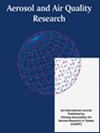扫街和洗街对减少近地细颗粒物及相关污染物水平有效吗?
IF 2.5
4区 环境科学与生态学
Q3 ENVIRONMENTAL SCIENCES
引用次数: 2
摘要
摘要本文章由计算机程序翻译,如有差异,请以英文原文为准。
Do the Street Sweeping and Washing Work for Reducing the Near-ground Levels of Fine Particulate Matter and Related Pollutants?
This research focuses on the properties of near-ground fine particles (PM 2.5 ), ultrafine particles (UFP), black carbon (BC), and polycyclic aromatic hydrocarbons (PAHs) in traffic area. The effects of street sweeping and washing on pollutant levels are evaluated. The X Road with sewage ditch was selected for the stationary samplings to determine the differences between the atmospheric PM 2.5 mass concentration, their composition, and potential sources before/after street cleaning processes, as well as the effect of the sewage existence. Results show that there were certain reductions of PM 2.5 after the street washing, especially for the road section with drainage ditch. The chemical mass balance model then pointed out the traffic contribution on PM 2.5 significantly reduced on the downwind site (from 25.7% to 16.5%). Besides, the spatial distribution of the near-ground PM 2.5 , UFP, BC, and PAHs were monitored by a mobile platform on an appropriate long, straight, and not heavily traffic Road Y. The monitoring took place at 1 h-before, during washing/sweeping, at 1 h-after, at 1 d-after, at 2 d-after three cleaning strategies, including only sweeping, washing-before-sweeping, and sweeping-before-washing. The monitoring then mapped out the hot spot distribution of pollutants. The PM 2.5 mass, UFP number, BC, and PAH concentrations before the street sweeping is 155 µ g m –3 , 1.2 × 104 # cm –3 , BC 3633 ng m –3 , and 36 ng m –3 . The UFP number concentration of suspended particles after street washing had a trend to reduce, avoided the deterioration of air quality. The strategy, “sweeping-before-washing”, was the best operation method among three to suppress the UFP number concentration by 42%, while all three strategies could effectively reduce the PAH levels. The primary pollutants are more easily reduced by the street-cleaning process, while the secondary one did not.
求助全文
通过发布文献求助,成功后即可免费获取论文全文。
去求助
来源期刊

Aerosol and Air Quality Research
ENVIRONMENTAL SCIENCES-
CiteScore
8.30
自引率
10.00%
发文量
163
审稿时长
3 months
期刊介绍:
The international journal of Aerosol and Air Quality Research (AAQR) covers all aspects of aerosol science and technology, atmospheric science and air quality related issues. It encompasses a multi-disciplinary field, including:
- Aerosol, air quality, atmospheric chemistry and global change;
- Air toxics (hazardous air pollutants (HAPs), persistent organic pollutants (POPs)) - Sources, control, transport and fate, human exposure;
- Nanoparticle and nanotechnology;
- Sources, combustion, thermal decomposition, emission, properties, behavior, formation, transport, deposition, measurement and analysis;
- Effects on the environments;
- Air quality and human health;
- Bioaerosols;
- Indoor air quality;
- Energy and air pollution;
- Pollution control technologies;
- Invention and improvement of sampling instruments and technologies;
- Optical/radiative properties and remote sensing;
- Carbon dioxide emission, capture, storage and utilization; novel methods for the reduction of carbon dioxide emission;
- Other topics related to aerosol and air quality.
 求助内容:
求助内容: 应助结果提醒方式:
应助结果提醒方式:


